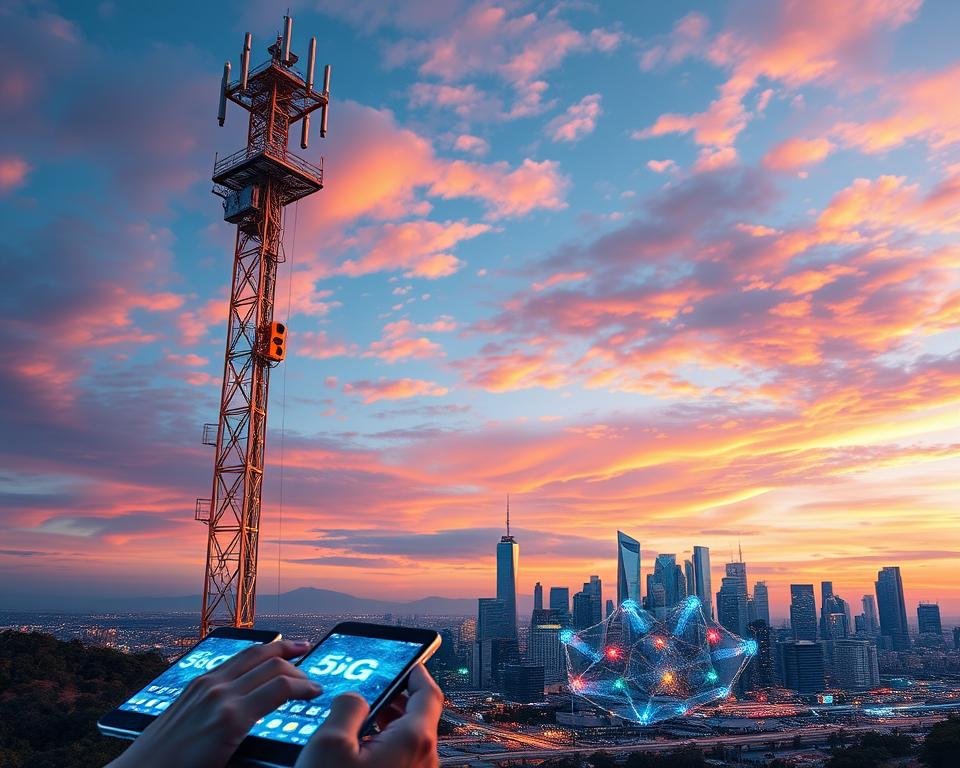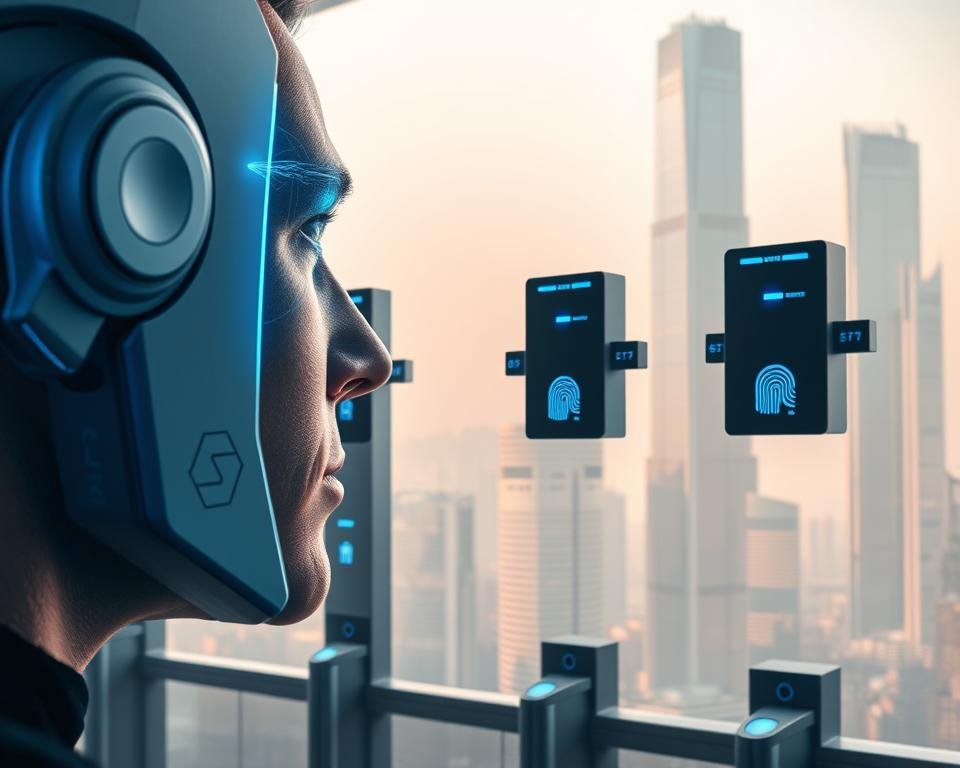Exploring the latest tech shows how important it is to stay up-to-date. In this article, I’ll show you the top tech advancements everyone needs to know.
Technologies like artificial intelligence and renewable energy are changing our lives. I aim to give you a deep dive into these innovations and their effects.
Key Takeaways
- Understanding the role of artificial intelligence in future technologies.
- The impact of renewable energy on sustainable living.
- How emerging technologies are transforming industries.
- The importance of staying informed about technological advancements.
- Innovations that are expected to shape the future.
Understanding the Concept of the Future in Tech
Looking into the future of tech means seeing how tech has grown and where it might go. We must look back at how tech has changed our world.
What Does the Future Mean for Technology?
The future of tech is more than just new devices. It’s about how these changes will make our lives better and more connected. The upcoming trends in tech will change how we live and work.
Key areas to watch include next-generation tech. This tech will improve how we talk, work, and have fun. As tech keeps getting better, we’ll see big improvements in many areas.
Historical Context: How Technology Evolved
Technology’s growth has been slow but steady. Each new tech has built on the old. From early computers to today’s AI and machine learning, tech has made huge strides.
| Era | Technological Advancements | Impact |
|---|---|---|
| Early Computing | Development of the first computers | Paved the way for modern computing |
| Internet Era | World Wide Web, email, online services | Revolutionized communication and information access |
| Modern Era | Artificial intelligence, machine learning, IoT | Enhanced efficiency, connectivity, and innovation |
Understanding tech’s past helps us see its future. This way, we can guess what’s next.
The Rise of Artificial Intelligence
In recent years, Artificial Intelligence has become a big player in futuristic developments. It’s changing how we live, work, and use technology. It’s important to see how AI affects different areas.

Key AI Technologies to Watch
Several AI technologies are making big moves. These include machine learning, natural language processing, and computer vision. They’re being used in many fields to boost innovation and efficiency.
Machine learning lets systems learn from data and make choices on their own. Natural language processing makes talking to machines easier. Computer vision is changing healthcare and security.
Industry Applications of AI
AI is used in many industries, like healthcare, finance, transportation, and education. In healthcare, AI helps with diagnosis and tailored treatments. In finance, AI spots fraud and assesses risks.
- Healthcare: Diagnosis, personalized medicine
- Finance: Fraud detection, risk assessment
- Transportation: Autonomous vehicles
- Education: Personalized learning
Ethical Considerations in AI
As AI grows, so do ethical concerns. There are worries about AI bias, privacy, and jobs lost. We need to make sure AI helps everyone.
Developers and leaders must create forward-thinking rules. These rules should help AI grow while keeping its risks in check.
Blockchain: Beyond Cryptocurrency
Technology keeps getting better, and blockchain is a big step forward. It’s not just for digital money. It’s a new way to keep data safe and open.
How Blockchain Works
Blockchain uses a network without a single boss. Many can record deals without needing someone in charge. It works through a chain of blocks, each with a list of deals.
Key components include:
- Cryptography for secure transactions
- A decentralized network for consensus
- A public ledger for transparency

Applications in Different Sectors
Blockchain is useful in many areas. It’s used in:
- Finance: for safe and quick deals
- Supply Chain Management: to track and check goods
- Healthcare: for safe medical records
These uses show how blockchain can make things better. It can make things safer, clearer, and more efficient.
Challenges Facing Blockchain Developers
Even with its benefits, blockchain has big hurdles. These include:
- Scalability issues
- Regulatory uncertainty
- Security vulnerabilities
Fixing these problems is key for blockchain to be widely used.
The Internet of Things (IoT) Revolution
The Internet of Things (IoT) is changing our world. It connects devices, vehicles, and home appliances. They can share data thanks to sensors and software.
Connecting Everyday Devices
IoT makes our lives easier. It connects devices like smart home appliances and health trackers. For example, smart thermostats adjust the temperature for us.
IoT-connected devices offer many benefits:
- They work more efficiently and automatically.
- They make our lives more personalized.
- They help us save energy and money.
The Impact on Smart Cities
IoT is key for smart cities. It helps manage resources better and keeps cities safe. For instance, smart traffic systems reduce congestion.
| Smart City Application | Description | Benefits |
|---|---|---|
| Smart Traffic Management | Real-time traffic monitoring and optimization | Reduced congestion, lower emissions |
| Smart Energy Grids | Efficient energy distribution and management | Cost savings, reduced waste |
| Smart Public Safety | Real-time surveillance and emergency response | Enhanced public safety, rapid response |
Security Concerns in IoT
IoT’s growth raises security worries. More devices online means more threats. We need strong security to protect our devices and data.
In summary, IoT is changing how devices interact. It’s driving innovation and shaping our future. But, we must tackle security issues as IoT grows.
Virtual Reality and Augmented Reality
I’m really into Virtual Reality and Augmented Reality. These techs are changing how we see the digital world. They’re set to change many parts of our lives, like fun, learning, and health.
Differences Between VR and AR
Virtual Reality (VR) and Augmented Reality (AR) are different. VR makes a digital world that you can’t see the real one. AR adds digital stuff to the real world, making it better.
Key differences include:
- Environment: VR makes a digital world, AR makes the real world better.
- Immersion: VR pulls you in fully, AR doesn’t.
- Applications: VR is for games and simulations, AR is for adding digital info to real things.
Current Applications in Gaming and Beyond
VR and AR are big in gaming, giving us new ways to play. But they’re used in more than just games.
Some current applications include:
- Gaming: Better, more real experiences.
- Education: Makes learning fun and easy.
- Healthcare: Helps doctors train and patients get better.

As VR and AR get better, we’ll see new uses in many fields. They have the power to change our lives in big ways. It’s an exciting time to learn about them.
Renewable Energy Technologies
Innovations in renewable energy are leading to a sustainable future. We’re finding new ways to use energy from nature. This makes it easier to stop using fossil fuels.
Renewable energy tech is key to fighting climate change. We need to know about solar, wind, and energy storage. This knowledge helps us be more sustainable.
Solar Power Innovations
Solar energy has made big strides. Some major advancements include:
- High-Efficiency Solar Panels: New tech lets us make panels that work better. This means we can get more energy from sunlight.
- Solar Energy Storage: We can now store extra energy from solar panels. This is great for later use.
- Bifacial Solar Panels: These panels work on both sides. This boosts how much energy they make.

Wind Energy Developments
Wind energy is also very important. Recent changes include:
- Larger Turbines: Bigger turbines with longer blades make more energy.
- Offshore Wind Farms: Wind farms at sea use stronger winds. This means more energy.
- Floating Wind Turbines: New tech lets turbines float in deeper water. This opens up new places for wind energy.
The Role of Energy Storage Solutions
Energy storage is key for using renewable energy well. It helps keep the grid stable. This ensures we always have power.
The future of energy storage looks bright. New battery tech and other methods are coming. As they get better and cheaper, they’ll help us use more renewable energy.
5G Technology and Its Implications
5G is the next big thing in wireless tech. It will open up new ways to use technology. We need to know how it works and how it will change our lives and industries.
Understanding 5G Networks
5G networks are a big step up from older ones. They offer faster data speeds and lower latency. This is thanks to new tech like millimeter wave spectrum and beamforming.
The 5G design is flexible and can grow with new needs. It supports everything from fast mobile internet to critical communications. This is key for different industries.

How 5G Will Change Connectivity
5G will change many areas, like healthcare, finance, and entertainment. For example, it will make remote healthcare better. This means we can have real-time talks and treatments.
It will also help make smart cities real. And it will improve self-driving cars and smart buildings.
- Enhanced mobile broadband experiences
- Mission-critical communications for emergency services
- Massive IoT deployments for smart cities
As 5G spreads around the world, its effects will be huge. It will change how we use and interact with technology.
Autonomous Vehicles: The Road Ahead
I’m excited to see how autonomous vehicles will change our daily commutes. They’re not just a dream; they’re becoming real. They promise to change how we move around cities a lot.
Advancements in Self-Driving Technology
Self-driving cars are being tested and used by many companies around the world. They use sensors, GPS, and artificial intelligence to drive safely. Companies like Tesla and Waymo are leading the way in this innovation.
This technology is getting better. It can now handle complex situations on the road. This makes self-driving cars safer than cars driven by people.

Regulatory Hurdles
Even with all the progress, there are big challenges to overcome. Governments are trying to make laws that keep us safe without stopping new ideas.
- Creating rules for testing and using these cars
- Figuring out who’s to blame in accidents
- Keeping these cars safe from hackers
Future Implications for Urban Mobility
The future looks bright for self-driving cars. They could make traffic jams disappear and change how cities are planned. Cars could talk to each other and roads, making traffic flow better.
Also, self-driving cars might change how we own cars. We might see more shared rides. This could mean fewer cars on the road and less pollution.
Biometric Technology and Privacy
I see a big change with biometric technology in our lives. This emerging technology is changing how we handle security and who we are.
Biometric methods use special features like fingerprints and facial scans to know who we are. They’re everywhere, from opening phones to making money deals.
What Are Biometric Techniques?
Biometric techniques use special traits to know who we are. This includes fingerprints, facial scans, and voice checks. They’re safer and easier than old ways like passwords.

Applications in Security
Biometric tech is used a lot in security. Airports use it for better checks, and banks use it for safer money deals. It’s the next generation of keeping things safe and easy.
- Enhanced security through unique identification
- Convenience in authentication processes
- Increased accuracy in identity verification
Balancing Privacy with Innovation
Biometric tech has many good points but also worries about privacy. As we move forward with this evolution, we must think about the risks of our biometric data. We need strong rules to keep our privacy safe while using new tech.
To find a good balance, we need strong privacy laws. This means clear rules for handling data, safe storage, and who can see it. This way, we can enjoy the benefits of biometric tech without losing our privacy.
Quantum Computing: The Next Frontier
Quantum computing is changing what we think is possible in tech. It’s exciting to see how it will change many fields.
Basic Principles
Quantum computing uses quantum mechanics. It uses quantum bits or qubits. Qubits can be in many states at once, making data processing faster.
Superposition and entanglement are key. They let quantum computers do things classical computers can’t.
Potential Applications
Quantum computing has many uses:
- Cryptography: Quantum computers can break old encryption but make new, safe ones.
- Drug Discovery: They can speed up finding new drugs by simulating molecules.
- Optimization Problems: They help solve complex problems in logistics and finance.
Future Challenges and Opportunities
Quantum computing has big challenges like fixing errors and keeping qubits stable. But, as research goes on, we’ll see big improvements.
The future of tech is linked to quantum computing. It will bring innovative solutions to hard problems.
The Future of Work and Technology
Technology and work are merging into a new future. The prospective outlook for jobs is changing a lot. This change is thanks to new tech.
Remote Work Trends
Remote work is becoming more common. It’s likely to keep growing. Thanks to digital tools, teams can work from anywhere.
This change is big for businesses. They’re now using new tech to support remote work. This includes tools for meetings, managing projects, and keeping data safe.
Automation and Job Evolution
Automation is also changing jobs. It might replace some jobs but also create new ones. The next generation of workers will need to adapt and learn new skills.
Jobs are becoming more tech-based. Workers need skills like thinking critically and being creative. These skills work well with automation.
Skills for the Future Workforce
The future workforce will need new skills. This includes technical and soft skills like teamwork and problem-solving. The evolution of work demands a flexible and learning workforce.
By learning these skills, people can be ready for the next generation of work. Companies can help by training and encouraging innovation.
Looking ahead, technology and work will keep shaping jobs. By understanding and preparing for these changes, we can look forward to a bright future for everyone.
Conclusion: Embracing the Future
Technology is always changing, and new things like artificial intelligence and blockchain are leading the way. It’s important to keep up with these new ideas. This helps us use their power to the fullest.
Staying Informed in a Rapidly Changing World
To stay ahead, we need to keep learning. Knowing the latest trends helps us understand new technologies. This way, we can get ready for what’s coming next.
Preparing for a Future Driven by Innovation
We must be ready to change and grow. This means learning new skills and using new tech. By being open to new ideas, we can make a better future for everyone.
FAQ
What are the most significant technological advancements that everyone should know about?
Big tech changes include AI, blockchain, and the Internet of Things (IoT). Also, virtual and augmented reality, green energy, and 5G are key. Autonomous vehicles, biometrics, and quantum computing are also important. These changes are making our lives better and will shape the future.
How is artificial intelligence being used in different industries?
AI is changing many fields like healthcare, finance, and education. It uses machine learning and natural language processing. These tools help make things more efficient and innovative.
What is the potential of blockchain technology beyond cryptocurrency?
Blockchain can make things safer and more transparent in many areas. This includes supply chains, healthcare, and finance. Its unique way of managing data is very secure and reliable.
How is the Internet of Things (IoT) revolutionizing the way devices interact?
IoT connects devices, making them talk to each other and their surroundings. This change is making our lives more efficient and sustainable. It also makes our environments more responsive to our needs.
What are the differences between virtual reality (VR) and augmented reality (AR)?
VR creates a digital world you can step into. AR adds digital stuff to the real world. Both are used in gaming and education to offer new experiences.
How will 5G technology change connectivity?
5G will make connections faster, lower latency, and more reliable. This opens up new possibilities for things like mobile broadband and self-driving cars.
What are the implications of autonomous vehicles for urban mobility?
Self-driving cars could make cities safer and less crowded. They could also change how cities are designed. This could make moving around cities more efficient and green.
How is biometric technology being used for security and identification purposes?
Biometrics like facial and voice recognition are used for security. They help in law enforcement, border control, and finance. These technologies make it easier to identify people.
What are the potential applications of quantum computing?
Quantum computers can solve problems that regular computers can’t. They’re used in cryptography, optimization, and machine learning. This could help in fields like medicine and finance.
How is technology changing the nature of work?
Tech is changing how we work, with big impacts on the future. Trends like remote work and AI are reshaping jobs. Workers need to learn new skills to keep up.
What skills will be necessary for the future workforce?
The future will need skills like critical thinking and creativity. As tech advances, it’s key to learn skills that match new technologies. This will help workers succeed in a changing job market.
How can I prepare for the changes brought about by emerging technologies?
To get ready for tech changes, stay updated and invest in learning. Be open to new chances and challenges. Being proactive and adaptable will help you benefit from new tech.





